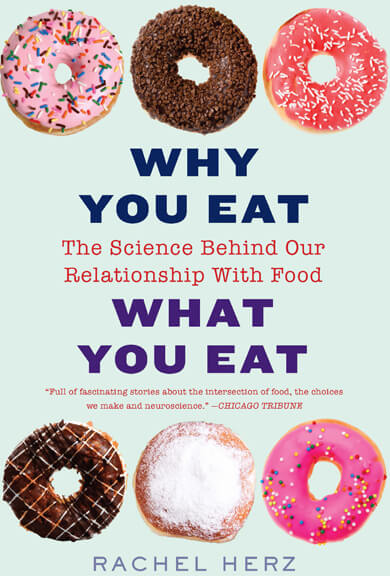Exploring the Psychological Science of Smell with Neuroscientist Rachel Herz
Rachel Herz, Ph.D., is a world-renowned neuroscientist, author and TEDX speaker who is an expert on the psychological science of smell. She was scheduled to speak as part of the Cultural Life Series at JWU just before the coronavirus struck. Ironically, one of COVID’s signature symptoms for many victims is the loss of smell and the enjoyment of food. Herz was able to reschedule — and recalibrate — her talk to include the repercussions of COVID-19.
Herz was the perfect person to educate us on the basics of flavor, taste and smell and to discuss the strange symptoms affecting many COVID victims. Her presentation, “Why You Eat What You Eat: A Taste of Some Surprising Sensory and Psychological Factors,” delved into how taste, smell and flavor are connected and how they are affected by our senses of hearing and vision. She explored why we eat what we eat — the types and amounts of food — and how our choices are influenced by music, scents, grocery shopping bags, the color red and other factors.

Flavor, Taste and Smell
Herz explained that there are four basic tastes — salt, sour, sweet and bitter. There are also other oral sensations: fat, umami (a meaty or savory sensation) and heat (the burning spiciness in food such as wasabi and horseradish).
Taste and flavor, Herz pointed out, are not what many of us understand them to be. “The reason why we often say the word ‘taste’ when we mean ‘flavor’ is because it’s coming from the mouth. There’s this illusion that that’s where it is. But, it’s actually your brain that makes flavor when it knits together the sensations of smell from your nose and taste from your mouth ... to create that sense of bacon, chocolate, steak, apple pies and so on.”
Using steak as an example, Herz explains, “Flavor is a combination of one or more of the basic tastes combined with an aroma. It is the combination of the saltiness and the steak aroma that gives us the flavor of the steak. Without aroma, there is no flavor. If I could not smell, the only thing I would perceive is the taste of salt.”
The Effects of COVID on Smell and Taste
"An extremely distressing experience” is how Herz described the problems that have been caused by COVID-19, wreaking havoc on many people’s sense of smell. “One of the critical symptoms of COVID-19 ... is people’s inability to smell or an altered sense of smell, when they’re smelling all kinds of bad things.”
Herz said these COVID symptoms have heightened awareness of the sense of smell, including a loss of “what we call taste,” when our sense of smell doesn’t function correctly. With COVID, “If people say they’ve lost their sense of taste it is more likely they’ve lost their sense of smell and the food does not have the normal taste qualities they’re expecting. So, the bottom line is that the combination of smell and taste is critical for our experience of food.”
COVID has also been involved in our eating habits in a different, indirect way, too. For years we’ve been encouraged to bring our own reusable bags to grocery stores to be environmentally conscious. COVID changed all that, at least temporarily, to help keep the virus from spreading by having customers use store-supplied, one-use bags. But, believe it or not, bags can affect people’s food choices when shopping. Herz relayed the story of a study done by Harvard University Business School and Duke University. One discovery was that when people brought their own bag, they tended to buy more organic products, to make another environmentally sensitive choice. But, those same people also bought more chips, sweets and other treats. “As a function of doing something responsible, they felt they could give themselves a little treat and reward themselves for being good.”

When using GPS to track shoppers’ carriages in the grocery store, another example of people rewarding themselves for being “good” was discovered. After choosing their vegetables and fruit, the next areas of the store customers frequently headed to was either the ice-cream or the alcoholic beverages section. This happened even when those sections were not on a direct path from the produce section. “So, we do something good and then reward ourselves with a vice … this effect is called licensing,” said Herz.
One of the presentation attendees, whose sense of smell was affected by COVID, asked Herz to talk about phantom smells. “This is a serious problem … and you know there’s a certain group of people who have had it persistently, potentially for at least a year.” Phantom smells, or phantosmia explained Herz, is the phenomenon of smelling something unpleasant, such as rotting food, that is not there. What’s more common is parosmia, a distorted sense of smell. An example is if you walk into a kitchen where someone is cooking food, but you smell something burning even though that is not happening. The good news, Herz noted, is that “parosmia usually means that the sense of smell is beginning to recover, which is better than smelling nothing at all.”
Herz’s advice for dealing with both smell loss and parosmia, is “smell training,” or “exercises for your nose.” The training involves using four distinct smells such as different spices and maybe adding in a perfume. Sniff each actively for about 10 seconds, four times a day for several months. “It seems to have a tremendous, positive benefit for people who have either parosmia or have lost their sense of smell. Many people start regaining their normal sense of smell again.”
Watch Herz and a clip from the presentation to JWU, below.
What we eat can be affected by things that we hear, smell and see, too. Herz gave us a taste of those:
An experiment was conducted in a UK restaurant to determine if background music affected customers’ dining experiences. They discovered that people listening to background music spent about 17 minutes longer dining than those who ate with no music playing. Those with music in the background also spent more money — about $4 more on food and $2 more on drinks. This study was conducted 20 years ago and with inflation the amounts spent would be quite a bit higher now.
Fast food restaurants want customers to come and go quickly. One way to do this is to use bright oranges and reds in the restaurants – such as red food trays. These colors urge people to eat faster and move on.
A study that exposed customers to the aroma of pizza for 10 minutes before serving it to them, revealed that those people ate 43% more pizza than people not exposed to the aroma beforehand. The good news is that this works for healthy food, too.
Herz ended her presentation with a positive sendoff: “Understanding the myriad sensory and psychological factors that influence our experience of eating will enable us to have a healthier and happier relationship with food, and that is my take home message for you all.”
Learn more about Dr. Herz at rachelherz.com.
Explore Dr. Herz’s latest book, “Why You Eat What You Eat: The Science Behind Our Relationship with Food" (2018).
Learn More About JWU's College of Arts & Sciences
Top photo (spices) by Calum Lewis on Unsplash.


